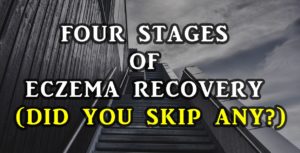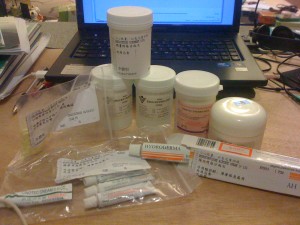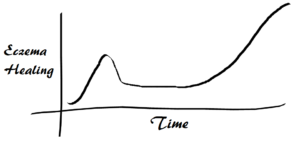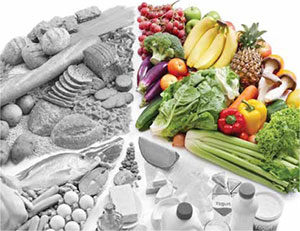G o ahead and “heal” eczema – whatever that means to you.
o ahead and “heal” eczema – whatever that means to you.
You probably know “leaky gut” or “paleo.” Conventional treatment is misdirected. The key is gut-based solutions backed up by nutritional science.
The problem: we know so many concepts and diets which (probably) work, except we don’t pay attention to how our body heals in terms of stages.
Creating questions like:
- When EXACTLY will my eczema heal?
- How come all you do is conveniently say “it depends”?
- Is Paleo, gluten-free, or dairy-free, etc, better?
- “I seem to be stuck. It’s not improving.” Why?
There are four universal stages of eczema recovery. Understanding will stop you from jumping around places – saves you a lot of time and unnecessary suffering.
Conventional Medicine: 3-Step Approach

Here’s how it works.
- Diagnosis. Check your symptoms, induce it into known cause e.g. itchy skin, inflamed, rashes, dryness. Highly liked to be eczema.
- Treatment. Using confirmed treatments to eczema (only control, no cure) e.g. steroid therapy and moisturizers.
- Prevention. Since eczema has not cure, prevention means applying steroids (before the patches appear), and other generic healthy eating advice.
By default, steroids are the primary solution in both treatment and prevention. Unfortunately in either case, there are no sub-steps on how you can use such solution appropriately to cater to individual needs, nor is there any attention put on nutritional importance.
Alternative Medicine: “Detoxification”

Many people have problems with this phrase. Me included.
In medical context, detoxification refers to alcohol intoxication, food poisoning, etc. In alternative medicine context, the term broadens to describe a general need to purge ourselves of internal toxins.
“Toxins” is an empty phrase. The problem is, the internet is filled with plentiful of unoriginal articles talking about “detox” without evidence or good explanations. I am not against Complementary & Alternative Medicine (CAM), because within any medical system including CAM itself, there is good CAM and bad CAM. What you want, is to read from sources providing evidence.
I recently came across an article from an eczema blogger called Jen Hall, who laid out 3 stages of what it means to detoxify:
- Elimination of toxins. Same as below except the order is misleading because toxin elimination occurs simultaneously and gradually with (2), instead of dumping one big load immediately.
- Breakdown and removal of diseased cells. Based on cellular waste deposited and accumulated through poor lifestyle habits – changes will facilitate their breakdown.
- Rebuilding of tissues. Jan reminds us there is no instant relief, and an incoming healing crisis. Here I add from personal experience, my healing crisis initiated immediately at (1) when I began to switch to a new mode of healthy eating.
This is an example of blogger-crafted piece (just as I do). If you read it, you can definitely sense an understanding of what it means to break free from ineffective conventional treatments. But some phrases like “pushing these toxins through the skin” ring a bell because while “toxins” can be un-shunned by understanding them through specific internal imbalances, it may be too much to physicalize some visible toxins literally coming of our body.
Message: Conventional medicine is too specific down to symptoms, it misses the root cause. CAM is too philosophical, it placebos (use it as verb) everything. In between, we need an evidence-based approach.
1. Warm-up Period
 Duration: 2-3 weeks, or longer (it depends).
Duration: 2-3 weeks, or longer (it depends).
People often ask how long it takes to recovery. “It depends” is a common answer. And that specifically means:
- Your lifestyle history. If you’ve been eating junk food for a long time, exercising little, etc, you’re going to take longer to readjust from that mode to a new way of healthy eating. There is no exact math formula of how long you suffered to calculate how long warm-up takes.
- Warm-up effectiveness. How well are you making changes to eat healthy during warm-up? Are you completely cutting everything and jumping into Stage 2 of Highly Restrictive Period (not suggested), or are you slowly cutting bad habits?
Personal reference: I had eczema since 6. Ate junk food as regular snack. Drank artificial formula milk every morning in primary school. Ate McDonald’s once per week. Stress in family for complicated reasons. Begun to eat healthy, eat more vegetables, to a more plant-based diet, 10 years later. I can’t recall exact time I realized I need to eat healthy, but I gradually became more nutrition conscious in early 2013 until my recovery began in June. You could say my warm-up took 5 months, which is long but acknowledge I was gradually eating healthy and not completely making restrictions. Many variables you see.
Actionable Changes
- Decrease steroids. Gradually taper off your conventional medications. If you immediately cut, the withdrawal symptoms are going to hurt.
- Analyze topical ingredients. Change your topical and shower products. If you find chemicals and fragrances, drop it. Get new lotions and body wash with only natural (or non-irritant synthetic) ingredients.
- Drop junk food. If you were eating high-meat and low-fiber, gradually do the opposite.
- Cut sugar. Gradually drop sugar consumption to minimum. We don’t need sugar to live. Limit your fruit intake of high sugary varieties. Understand that NOT all fruits are eczema-friendly.
- Eat selectively. Lower your carbohydrate intake on food staples like rice, noodle, pasta, and grain products. The purpose is to redirect the amount of food you eat to more nutrition-packed foods for recovery like seafood and vegetables instead of grains.
2. Highly Restrictive Period
Duration: 4-5 weeks. 
During this time, you should only eat food made with natural ingredients, no processed chemicals, and work within a highly restricted list of foods. For reference, you could use:
Although I used these for my 2013 recovery, there is a more accurate framework which I will post in the future. Just remember, an eczema-specific diet must be anti-inflammatory.
Actionable Changes
- On Cooking. Try to minimize the amount of burden you place to the body e.g. using too much oil. Replace neutral (or poor of course) habits not greatly advantageous, to more positive ones. Example: since you have limited stomach space, eat less meat and eat more fish.
- Commitment Habits. This period is usually the hardest to adjust because you’ll feel very limited to cooking at home, not going out with friends for a drink, etc. Find ways to keep yourself on track e.g. tell your friends about your recovery plan so they understand, get your family members to hold you accountable for not eating junk food.
3. Lightly Restrictive Period
Duration: 4-5 weeks.
Gradually reintroduce new food items by salicylates food guide. Introduce 2-3 items max at a week so you can trace any noticeable changes.
Consider getting a notepad to mark down the items that you’ve cleared from being able to reintroduce. Items that cause reactions, put them on hold and try again some time later. Don’t rush this because I personally learned that going too fast, you end up going back in progress because the body can’t handle it.
4. Cooldown Period

Duration: 2-3 weeks.
When I completed my 2013 summer recovery with a highly healthy AND intensive diet, I began school again and that meant no time to cook so I ate outdoors. Even though I barely touched junk food, some eczema returned. But I fixed it again in the next summer.
One takeaway is that eating healthy can get very extreme, and if you know you are going to change to a new work environment, new location, a new schedule of eating habits, or a switch from optimal healthy living to sometimes hanging out with friends eating without restraints, then we need to prepare our body with a cooldown.
Since your body has adjusted to restrictive dieting in previous stages, you should readjust it to being more flexible with a small percentage of sensitive foods. Otherwise, you will react strongly to sudden food introductions.
To Heal is To Track: What When Diets Fail?

Diets are just man-made systems.
To illustrate that, two years ago, I picked the common rules and concepts from 11 popular diets which claim to heal eczema, which is more important than any diet alone. You can call your diet any name, or focus on whichever area first. As long as your diet contains those common rules, it will make your body better.
But what when diets fail?
Track your progress one by one with a personalized elimination diet.
Suggested reading: Our Eczema Trials: Elimination Diet (How You Can Do It Too!)
When a diet fails to cover everything for you, you likely have specific food sensitivities. One example from a reader Arai:
A few days ago I decied to limiting my meat consumption to once a day, usually at lunch time and it made a huge diference. No more flareups at all! And the thinned skin on my hand is slowly getting normal again!
You are absolutelly right on the acid x alkaline chart stuff. I also noticed that red meat (beef) makes me break up badly, although skinless chicken and fish are ok (but sardines are not).
For him, a 80% vegetables and 20% meat diet would work in general, but a further personalized rule of cutting red meats and certain fishes is necessary to solve his eczema. He is most likely sensitive to amines e.g. red meats, preserved food, tomatoes.
This is the reason why an elimination diet to selectively test (using with your body’s reactions) food items is crucial to making that last breakthrough for smooth skin.
If You Eliminate Eczema, What Will You Do After?
Are you looking for a quick-fix by reaching a low-symptom plateau? Or are you aiming for further prevention by making yourself even stronger?
Following diets is okay, but how do you get over plateaus? Here are some quick last tips:
- Be proactive and analyze what’s slowing you. There is no way for me to be able to help you if you don’t critically evaluate your environment, your dietary intake, your lifestyle habits. If something is not right, there probably is a cause that you can search for and solve.
- Eating well by default. Eating healthy nowadays seems to be a solution rather than a prevention technique.
- Boost your immune system. Eczema is an autoimmune disease, a product of a dysfunctional immune system. The simple yet effective solution is the trio – stress less, exercise more, sleep well.

For those who know me, you may know that I have just begun school two days ago as a year 2 in university. However, throughout the whole year, I’ve eaten healthy in general except with periodic desserts with friends, slept little and binged on two cups of instant coffee per day, I had remnants of eczema that seem to come on and off.
I found the solution: coffee.
I needed coffee to function every morning. I know it is very stimulating to our endocrine system. After 1 year, I decided it was time for me to get into better skin. I need to show what I preach. I lift weights around twice per week. Completely banned coffee. Eat enough vegetables. Cut fruits (the sugar problem).
My skin now flares only if I break those rules again. Sleep being the most common culprit. Sugar being next.
Now… hello readers, I would really like to hear your voice. When was the last time you had a flare? What do you suspect the cause was? How do you manage your eczema in terms of diet? Which stage are you at right now?
Nice to see that my comment was useful for you. I didnt know about that amine stuff, so after you said that, I did a little research and it makes sense. From now on I’m gonna follow a low amine diet.
Btw, I am a girl 🙂
Hey Harrison ,
I must thank you for your blog because when I stumbled across it and it led me to Dr Mark Hyman’s work and when I read your articles and implemented them , I found massive healing take place . And prior to this I had been having extensive eczema for over 10 years and it was seriously bad and at a chronic stage (face, back, arms, legs)
Thank you for making your articles available to the eczema community in a easy to read manner, accessible and straight to the point . A little sharing on my end, when I had cut out rice from my diet it speed up recovery, but when I indulge in it once in a while there is some thickening of the skin . I had to cut out GMO stuff like wheat, corn, soy and vegetable oil (only take coconut oil) during that 2 year period. I had to carefully look at the fruit and vege listing that you posted on your blog for eg tomato, nightshades during that 2 year period but once I worked on reparing the leaky gut, my skin is no longer super reactive to triggers as it was once used to be. The reaction I get now is thickening of skin at my elbows or knees but none of the itchy sensation and it goes off after a few days.
I find Vitamin D intake via supplement to help in early stage and used to drink thick brew of 2 kg of ginger boiled water daily during 2 year period and found that speed my recovery and also did OPM- Origin Point Medicine which is massage of acupressure points on body- they have a Facebook page on that.
I feel I’m in the final stage where I know what to avoid and my boundary line when I eat certain foods but that’s pretty much because I stick to a strict diet most of the time with minor cheat meals.I remember you addressing the social aspect of a strict diet in one of your articles and found that I was very paranoid about not cheating over 2 year period hence didnt eat out at all but now have learnt my boundaries and what is a safer cheat meal vs not so safe cheat meal as in occasional rice is ok but wheat is a definite no no for me.
Thanks for the great work you have been doing ! 🙂